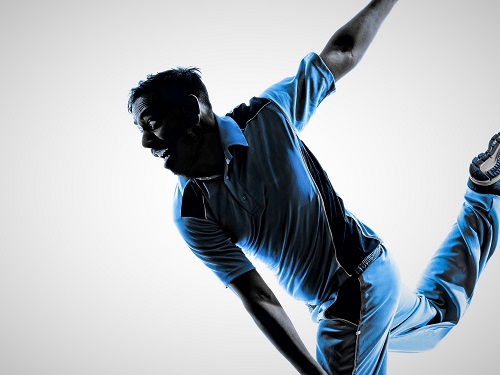|
 Want to get more spin? Want to get more spin?
While a high number of revolutions is great to have, learning to direct those revolutions is a skill overlooked. In fact, to many, the direction they spin the ball is simply the direction they spin the ball. Either you've got it or you haven't.
Rubbish.
Spin can be learnt. Much in the way that speed can be taught. You can make people bowl faster and you can also help them to spin the ball more and in almost all conditions. Yes, some may have a predisposed advantage. But, everyone can improve. The ceiling is a long way from the elite, never mind the masses.
The toughest conditions for a finger spinner are often found when bowling on the brand new, hard, flat pitch. While such conditions may offer light relief of some bounce, without the ability to generate turn, it can force many a spinner in a defensive mode. Not because it won't spin, but because they can't spin it. Generating turn on a quality batting surface requires top spin combined with side spin to get and real traction with the surface and the faster you bowl, the more of this top spin you'll need.
So how do we achieve this top spinning off break?
Simple.
Bowl from a front on position. That may have many "side on" classicists spitting out their drink. It doesn't mean we should be front on throughout the action. It simply means that if we can get our hips and shoulders to, or beyond a square on position by the point of release, then we've got a good chance of spinning the ball forwards and subsequently gaining grip with the surface.
Just try it for yourself. Imagine you're trying to spin a ball forwards standing in a side on position and again from a squad / chest on position. It's so much easier.
But how can a spinner achieve this front on release position?
From a technical perspective, to give ourselves the best chance of rotating our body into or past this square on position, we have to understand "inhibitors" and "enablers".
What are we doing to reduce the amount of rotation we get, which is subsequently limiting our ability to get to, or beyond square on?
These things are inhibitors.
Additionally, what do we do that helps stimulate or create rotation, encouraging our body to rotate more towards, or potentially beyond that square on angle?
These are enablers.
Some of the inhibitors you should look out for:
- Landing in a closed off angle during your delivery stride. This makes it much harder for your back leg to drive forwards and rotate your hips. Aim to keep them landing in a straight line towards where the ball is going.
- A long delivery stride. While often useful for fast bowlers, a longer stride acts as a larger, slower, turning circle for a spinner. While also creating a lower position with flexion at the hips. Both things restrict rotation movement.
- Falling away throughout the delivery. Good vertical alignment will always create more efficient rotation as it requires less force, so think tall and balanced with your head above your feet.
- A bent front leg won't rotate as efficiently as a straight one, in the same way that a flexed body or trunk would be less efficient than a vertical one. So aim for a braced front leg to maximise your rotation.
A selection of enablers you should consider developing are:
- Momentum moving forwards into the jump and delivery stride will initialise the rotation. Having your body weight forwards will also transition you onto your front foot more quickly, again aiding with rotation. So try to attack the crease with plenty of energy.
- A powerful pulling motion with your non bowling arm. Pulling backwards drives the bowling shoulder forwards stimulating the rotation, while pulling downwards slightly can enable a shoulder angle that further enhances top spin on the ball. Consider what arm angle may help develop more rotation or a steeper shoulder angle. It's a trade off of the two combined to make you're own personalised pulling motion. Remember that a full extension of this front arm creates more potential energy on the way back, so stretch out then pull if you can.
- Driving the bowling side knee through your delivery stimulates rotation from the hips.
- landing with a back foot in a front on position (pointing towards the target), will encourage an opening of the hips through the delivery stride, developing rotation from the ground up. This works in a similar way to the pre turn a fast bowler should be striving to develop.
Developing a combination of these enablers, while limiting the inhibitors, can allow the hips and shoulders to achieve the square on position at the point of release we're after and from that position any finger spinner should be well set to get the ball spinning forwards. Offering them the chance to turn the ball on almost any surface.
So how should you apply all this information to your bowling?
The first thing I'd do is assess what you can achieve already.
If you can already spin the ball on every surface you play on, don't go looking for big changes. However, if you're looking for more consistent turn, a simple assessment of what you can make the ball do is easy. Get yourself a half and half, red and white ball and film yourself bowling. You should be able to see fairly quickly which direction you're spinning the ball in. You probably won't even need a camera.
If you're not managing to get the ball spinning forwards as much as you'd like, then start to assess your body position at the point of release. The best way to do this is to film yourself from side on. Think straight extra cover, level with the stumps. From here you'll be able to see how much rotation your gaining by the point of release, towards that square on position you're hoping for.
If you're not getting the ball spinning forwards and you're not getting square on, or beyond; it's time start to working through those checklists of inhibits and enablers to buy yourself some more rotation.
No longer should the finger spinner be confined to a defensive role on a flat deck, just because they're a finger spinner.
Strive to be better. Do something tomorrow you couldn't do today.
Spin can be learnt.
To many, spin bowling will always be an art rather than a science, but that doesn't mean you can't learn more about it and improve the way the ball leaves your hand.
Sam Lavery is Head of Cricket Performance at Portsmouth Grammar School
Discuss this article with other subscribers
|

.jpg)
.jpg)


.jpg)
.jpg)
